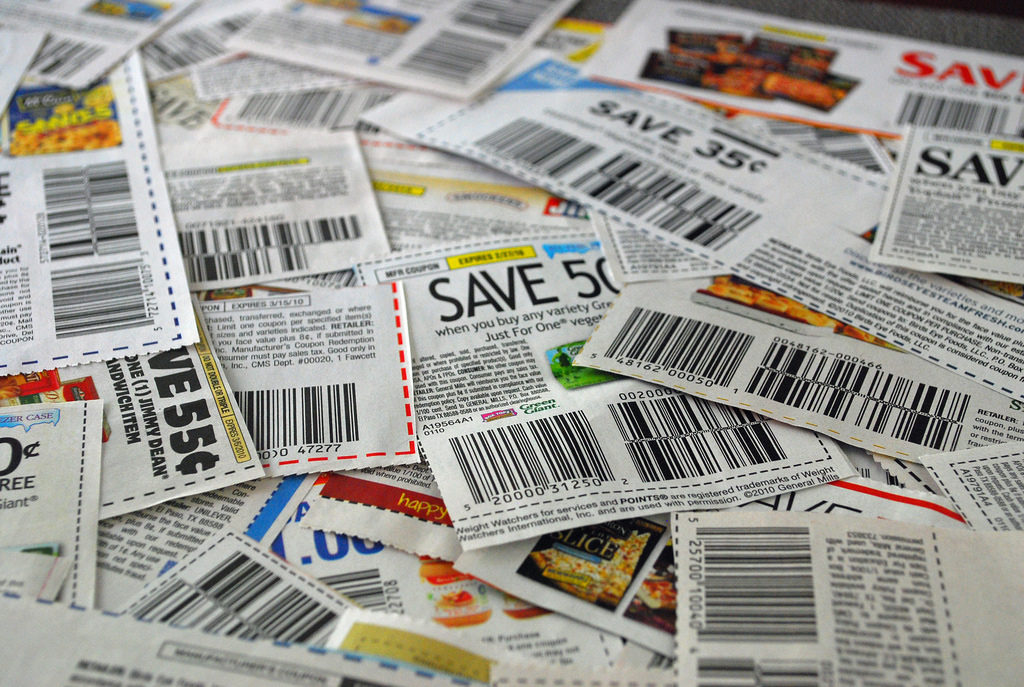
Coupons in the News marks its fifth anniversary this week! Back in 2012, some may have questioned whether there could possibly be enough news about such a niche topic to sustain a daily publication. But five years and nearly 1,500 news articles later – well, there’s your answer.
While the site’s mission to be the premier source of coupon news remains the same, an awful lot about couponing is much different now than it was just five short years ago.
So in honor of the anniversary, here’s a look at couponing then and now – the most notable developments in the five years since the launch of Coupons in the News:
“Extreme Couponing” fades away
Couponing has become a lot less extreme than it used to be. And many have blamed the demise of extreme couponing on, well, “Extreme Couponing”.
The controversial TLC show debuted as a weekly TV series in April 2011 and had just wrapped its third season at the time of Coupons in the News‘ July 2012 launch. But by that time, what had once appeared to be an entertaining enough show had turned polarizing – and damaging.
The show brought the underground recession-era phenomenon of extreme couponing into the mainstream – highlighting the big savings made possible by coupons. But it also exposed the tactics of the less-than-ethical. Show participants were seen cutting corners, bending and breaking the rules and eventually using coupons that were later confirmed to be counterfeit – anything to score bigger and better made-for-TV hauls.
Retailers and manufacturers responded by tightening coupon policies and introducing new restrictions on the number and types of coupons that could be used in a single transaction.
As a result, it’s much harder to get great – and legitimate – deals now, than it was before Extreme Couponing came along. Many longtime couponers have complained that Extreme Couponing “ruined couponing”.
That’s even though the show didn’t last for long. By the end of 2012, the series had fizzled out, airing what turned out to be its final episode to record-low ratings.
But even five years later, its legacy certainly lingers.
Read the fine print!
Take a look at the terms and conditions printed on this typical coupon from 2012: “Limit one coupon per purchase of product indicated. You must pay any sales tax.”
That’s all? How quaint!
Nowadays, coupons are filled with so much fine print, you need a magnifying glass to read it all, and a law degree to comprehend it.
Over the past five years, coupon issuers have added a slew of new rules and restrictions aimed at discouraging extreme couponing, fraud and behavior they’d rather not see.
“Not valid on trial/travel size.” “Void if copied, transferred, reproduced, sold or exchanged.” “No cash back if coupon value exceeds retail price.” “Limit of 4 like coupons.” Then “2 like coupons.” And then one.
So coupons certainly aren’t like they were just a few short years ago. Gone are the days when extreme couponers could stock up on travel-sized products, and score lots of overage with high-value coupons. Nor can you use as many “like coupons” as you’d like to in a single transaction. Nobody seems to know what it means to “proliferate” a coupon, but according to the latest fine print, it’s not allowed. You also can’t buy and sell coupons anymore, and you sure as heck can’t “exchange” them.
Well, at least in theory. Some of the restrictions are more effective than others, in preventing the activity their authors seek to deter. But from the coupon issuers’ perspective, spelling out the rules – whether or not all couponers honor them and cashiers enforce them – is better than not having rules at all.
The decline of double coupons
Did your favorite grocery store double coupons in 2012? Does it now?
Prior to the era of extreme couponing, several stores had tried eliminating double coupons – then quickly relented in the face of public and competitive pressure. But once the dreaded “extreme couponer” had become public enemy #1, some stores didn’t much care what couponers thought about their policies anymore.
Kroger first tested the waters in 2011 by phasing out double coupons in its Texas stores. And in 2012, around the time Coupons in the News started up, the anti-doubles avalanche began. From Kroger-owned Ralphs in April 2012 to Kroger’s Tennessee stores in February 2017, the nation’s largest grocery chain eliminated double coupons region by region until it was out of the doubles business for good.
Since grocers fund double coupons out of their own pockets, many had long been looking for an opportunity to quit them and keep more of their own money. Some saw discontinuing doubles as a way to combat extreme couponing, but Kroger denied that was the case.
Instead, the rise of digital coupons gave them the opening they were looking for. As more people use digital coupons, which don’t double, “we feel it’s an ideal time to test out a new money-saving program,” Kroger explained. But many shoppers aren’t so sure that any new “money-saving programs” are as good as double coupons were.
Emboldened by their larger competitor’s move, a number of other grocery stores followed suit and got rid of double coupons as well over the past five years. So what was once a commonplace promotional perk is increasingly becoming a much-missed relic from the good ol’ days.
The rise of digital coupons
Digital coupons were around prior to 2012, but not every store offered them. Today, nearly everyone does.
It was a swift rise for the format, which had some digital devotees predicting a few years ago that paper coupons would be dead and gone by now. That hasn’t happened, of course, as digital coupons are still far from dominating. But there’s no denying their growing popularity.
Back in 2012, according to Inmar, digital coupons represented just 0.4% of all coupons redeemed. In 2016, that figure was 3%. So paper coupons still dominate by far, but digital coupons’ share is rising rapidly – by 750% in fact, over just the past four years. At that rate, digital coupon redemption could actually surpass paper coupon redemption by sometime in the coming decade.
But will it? Sure, in our increasingly digital age, clipping, redeeming and processing paper coupons is inefficient, anachronistic and fraught with fraud. But old habits die hard. The 2012 prognosticators who predicted paper coupons would be gone within five years have been proven wrong. And the landscape is littered with defunct startups that boldly proclaimed the death of the paper coupon, which continues to hang on.
Coupon issuers are hedging their bets and preparing for the future by devoting more resources to digital, while continuing to churn out hundreds of billions of newspaper insert coupons that seem woefully outdated in comparison. But companies wouldn’t keep issuing them, if they didn’t work.
Ultimately, it’s not known whether consumer demand for digital will push coupon issuers to give up printed coupons for good, or whether the industry will be the one to nudge consumers to give up their preference for paper.
Either way, it may a while before paper coupons go extinct – if they ever do. But the continued rapid growth of their paperless counterparts shows that digital coupons are certainly here to stay.
The rise of rebate apps
At the time of Coupons in the News‘ July 2012 debut, no one had heard of Ibotta or Checkout 51 yet. Both officially launched later that year, ushering in a brand new way to save on your groceries.
“Instead of just transferring the tired old coupon format onto a mobile device, Ibotta has taken a fresh approach that gives people a fun new way to earn cash when they shop,” Ibotta founder and CEO Bryan Leach said at the time.
“We looked at coupons and how they worked and it’s a pretty broken system,” Checkout 51 co-founder Noah Godfrey said around the same time.
Why, they sound just like all of those defunct startups that boldly proclaimed the death of the paper coupon!
But in this case, they were onto something.
Shoppers have embraced rebate apps as a new way to save. Couponers like combining the rebate offers with coupons in order to stack their savings, while noncouponers like having the ability to save without putting in all the effort of clipping coupons at all.
Using your phone to scan bar codes and receipts has quickly become as commonplace as cutting out barcodes and mailing in receipts was not all that long ago – and you no longer have to wait months for a rebate check to arrive.
Today, in addition to market leaders Ibotta and Checkout 51, there are plenty of competitors, including MobiSave and SavingStar, both of which actually preceded Ibotta and Checkout 51 by a year, along with BerryCart, bevRAGE, Makeena and more.
But launching a rebate app doesn’t guarantee instant success. For every successful app, there’s been an Endorse, Snap or Shrink that’s fallen by the wayside.
And don’t forget Shopmium. That particular rebate app best exemplified the hand-wringing that brands have been doing over these newfangled savings platforms ever since they came onto the scene. Are cash-back offers like digital coupons, which can’t be combined with other coupons? Or are they like store coupons or mail-in rebates, which can?
Once it was acquired by Coupons.com owner Quotient Technology, Shopmium chose to treat its offers like digital coupons – preventing users from stacking discounts. Many users responded by abandoning Shopmium for its more coupon-friendly competitors. Ultimately, Shopmium was phased out as a standalone app and folded into the Coupons.com app itself.
For the time being, then, the issue of stacking and whether to allow it has not been settled definitively. But one thing is for sure about these rebate apps – in just a few short years, what was once a novelty has become a true alternative to traditional couponing.
Glitchers gain prominence
Coupon fraud has always been a problem plaguing the industry. But the manner in which fraudsters have tried to cheat the system has evolved over the past five years.
There will always be people who photocopy coupons or try to fool gullible cashiers with crude, questionable-looking fakes.
By 2012, though, counterfeiters were already getting somewhat sophisticated. That was the year the so-called “Coupon Guy” was convicted of creating and sharing custom-made software that allowed users to make completely legitimate-looking fraudulent printable coupons. Meanwhile, in one of the very first stories that appeared on Coupons in the News, three Phoenix women were arrested for selling high-quality free-item coupons that were believed to have been professionally printed overseas.
But it doesn’t take a printing press or computer coding skills to pull one over on coupon-issuing companies. Scammers have since gravitated toward using legitimate coupons to get illegitimate deals.
“Glitchers” gained prominence several years ago, as the latest iteration of coupon decoders. When the industry retired the older, easier-to-decode UPC bar code in favor of the more complex, accurate and harder-to-crack GS1 bar code, the glitchers responded by upping their game. They now use high-tech tools like the QSeer app to find and exploit “glitches” in coupons’ bar codes, which allow them to be accepted on products for which they’re not intended – then they share their finds in closed social media groups, where hundreds or thousands of fellow glitchers eagerly take advantage of the “deals”.
Still others are beating printable coupon providers at their own game, figuring out ways to get around the two-print limit and generate as many unique copies of printable coupons as they’d like.
While counterfeit coupons remain a challenge, they’re far from the only type of fraud the industry faces. Their tactics may have evolved in recent years, but it comes to less-ethical couponers trying to beat the system – some things never change.
Skip the store and go online!
Back in 2012, the notion of going online to shop for your groceries sounded like a post-Webvan-era joke. Webvan crashed and burned in 2001 after trying and failing to make online grocery shopping work. So why would anyone else bother trying?
These days, though, online grocery shopping has become a real thing. It’s not quite mainstream, but it appears to be getting there. And Amazon’s announcement last month that it plans to buy Whole Foods Market has ushered in a whole new round of predictions that traditional grocery stores will soon go the way of bookstores and record stores.
But if you end up buying your groceries online, the same way we’ve become accustomed to buying books and music – how will you use paper coupons without a cashier to scan them for you?
Many grocery delivery services accept digital coupons only. Others employ an imperfect solution of accepting your paper coupons, tallying them up after you’ve already paid, and giving you a credit on your next order. And one coupon publisher has even experimented with offering paper coupons that you can redeem online by scanning them with your phone.
Paper coupons as we know them have been around for more than a century now. Figuring out how to transfer these offline savings vehicles to an online world is another example of how challenging it can be to adapt an old-school format to a rapidly changing marketplace.
Coupons fall out of favor
Finally, with all the talk of “extreme couponing”, you’d think couponing was never as big as it was a few years ago.
But coupon use actually hit its peak in the early 1990’s. It spiked again during the recent extreme couponing craze, though not quite as high.
Ever since 2012, however, it’s been on a precipitous decline. So much so, that coupon use last year fell to its lowest point in more than four decades. According to Inmar, 2.2 billion coupons were redeemed last year, down from the recent high of 3.5 billion in 2011, and way down from the record high of 7.9 billion in 1992.
Now that truly extreme couponing isn’t really a thing anymore – is couponing itself about to suffer the same fate?
Just review all of the changes that coupons and couponers have experienced over the past five years. Coupons are much more restrictive than they used to be. Fewer stores are doubling coupons. There are more places like ALDI, Lidl and Amazon that don’t accept paper manufacturer’s coupons at all. And new digital savings platforms, personalized pricing and rebate apps are becoming attractive alternatives to those who just don’t want to bother with coupons anymore.
Five years is a relatively short period of time in the grand scheme of things. But in the five years since Coupons in the News came along, we’ve seen major changes in how we use coupons and go grocery shopping.
What will the next five years bring? It’s anyone’s guess. After all, who could have predicted five years ago that rebate apps would be invented, digital coupons would still be years away from becoming dominant, and Amazon would be running grocery stores?
With your continued interest and support, Coupons in the News will be around for the next five years and beyond, to bring it all to you. So thank you for reading – and happy couponing!
Photo by ePublicist











Mobisave was actually well before ibotta. It took a break for almost three years and came back. I was r coving rebates from them in January, 2012.
You’re right – how quickly one forgets, since there’s even an article about it on CITN (MobiSave was founded back in 2009, began beta testing in 2011 but didn’t “officially” launch until much later, so technically it was actually the first of the bunch).
Congrats on the 5-year milestone! This article is an excellent summary of the coupon industry and how it has evolved. Thank you for continuing this important service that benefits the entire coupon ecosystem — manufacturers, retailers, consumers, agents/suppliers, bloggers, etc. — while also serving notice to the glitchers and scammers that they are being watched and that the industry is constantly adapting in an effort to thwart their evil deeds! Keep up the great work!
Thank you, Honest Couponer!